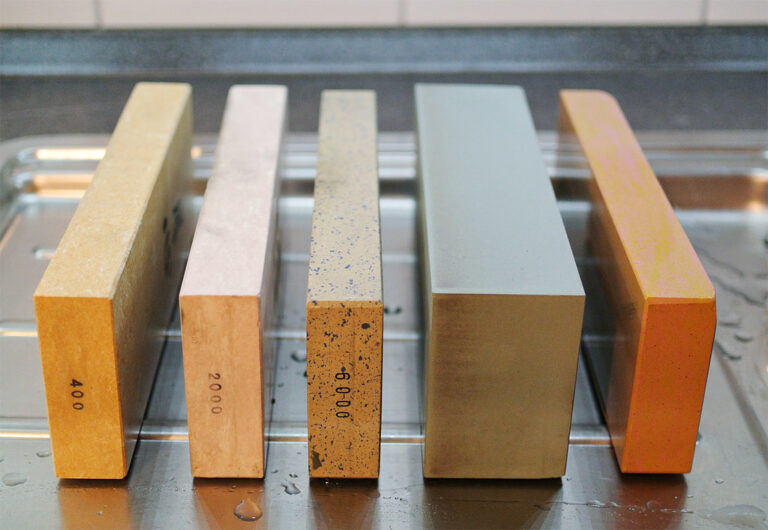There are probably as many ideas about the best way to sharpen hand tools as there are woodworkers; too many to cover in the newsletter. But the key item required for all sharpening schemes is an abrasive surface, usually several sharpening stones. The great variety of stones and the nomenclature describing them can be confusing. In this article I hope to provide some clarity.
“Oil stones” made from a natural material are the traditional choice. The finest natural stones are made of novaculite, a sedimentary rock related to flint or chert. There are large deposits of novaculite in the Ouachita mountains of Arkansas and in Oklahoma. Beginning around 11,500 B.C. Native Americans used it to make arrow heads, knives and scrapers with the technique called flint knapping – using an object to chip away at the edge of another stone. In the late 1800's whetstones called Washita or Arkansas were marketed in the U.S. and became the popular choice for sharpening.
Novaculite varies in hardness from a relatively soft white stone (Washita) to a harder black (Arkansas) form and the extremely hard and most expensive translucent form. Speed of cutting action varies inversely with hardness. The harder the stone the finer the polish.
Man-made oil stones are now available which consist of abraisive particles compacted into a hard block with a binder. The most common products are made under several brands in different grades of hardness. Many use aluminum oxide as the abraisive and are called “India stones”. Silicon carbide, available in a wider range of grits, can also be used and produces a faster cutting action. Norton, among other producers, makes one under the brand name, Crystolonä.
“Water stones” are also man-made with aluminum oxide or silicon carbide but with a water resistant binder. They have the advantage of faster cutting than an oil stone of similar grit. However, because water stones are softer than oil stones, fresh surface is exposed faster as it wears away. As a result they require flattening more often than an oil stone. Many users find them less messy than oil stones. They need soaking before use.
Diamond stones are made by bonding a layer of tiny diamond particles to a metal plate. This layer can be continuous or interrupted by small openings, the purpose being to catch “swarf”, a slurry of debris resulting from the cutting action. The interrupted style is most common, cuts very fast but is not suited for pointed tools. Diamond stones are extremely flat, remain so and last a very long time. Particle sizes from 100 to 2 microns are available (for comparison a hard Arkansas stone is 8-15 microns). They can be used to flatten oil or water stones. Two types of diamond can be used; mono-crystalline or poly-crystalline. The former is preferred because it lasts longer. They are, of course, very expensive.
Ceramic stones are the latest development in sharpening. They are made of fused alumina – aluminum oxide exposed to extremely high temperature under special conditions. The layer of fused alumina is bonded to a thin glass plate. These moderately expensive, high tech stones offer a very flat surface, no soaking just a splash of water, and very positive reviews for fast action and excellent results. A very wide range of grits is available. There is an active online debate about the two leading brands; Shapton and Naniwa. Spyderco also sells ceramic stones. I have never used one. A diamond lapping plate is required when they need flattening. You can have your own 16,000 grit, 8 1/4″x 2 3/4″, 5 micron Shapton Glasstoneä for $149.
Exotic stones worth mentioning. The Belgian Blue stone comes from the Ardennes in 4000 grit and is said to be of exceptional quality – a 6″X 2″ stone is $48.95. For fans of Japanese stones, consider a nagura (Japanese for correcting) stone. This is used to rub the surface of a sharpening stone to selectively correct high spots, clean up metal residue or create a fine abraisive slurry which produces a honing effect.
About flattening: Many choices for how to do this, from a diamond lapping plate to a Norton silicon carbide flattening stone for about $30 (I have one and like it), wet/dry sandpaper 120 – 220 grit on a piece of glass or just rubbing two stones of different grit together. To check your stone to see if it is flat, draw several pencil lines across the surface and then rub the flattening plate to see if they all disappear.
Bottom line With sharpening stones, like so many other woodworking tools, you get what you pay for. Quality rests on flatness, source and uniformity of abraisive particles, choice of backing, bonding and binding materials. My synthetic Japanese water stones were purchased over 35 years ago when The Cutting Edge was the only local supplier and they are as good as new. I have experimented with wet/dry sandpaper which works well but always seem to go back to the stones, although they take longer. I have tried a variety of honing guides and none of them are perfect. I would love to try a Lie Nielsen Honing Guide ($125). For more information about stones check out:
The Care and Use of Synthetic Waterstones on the Japan Woodworker website: japanwoodworker.com
Sharpening Supplies website: sharpeningsupplies.com
By Dick Ugoretz (originally published on October 2016)
Editor's Note: Light edits have been made to remove broken web links.

